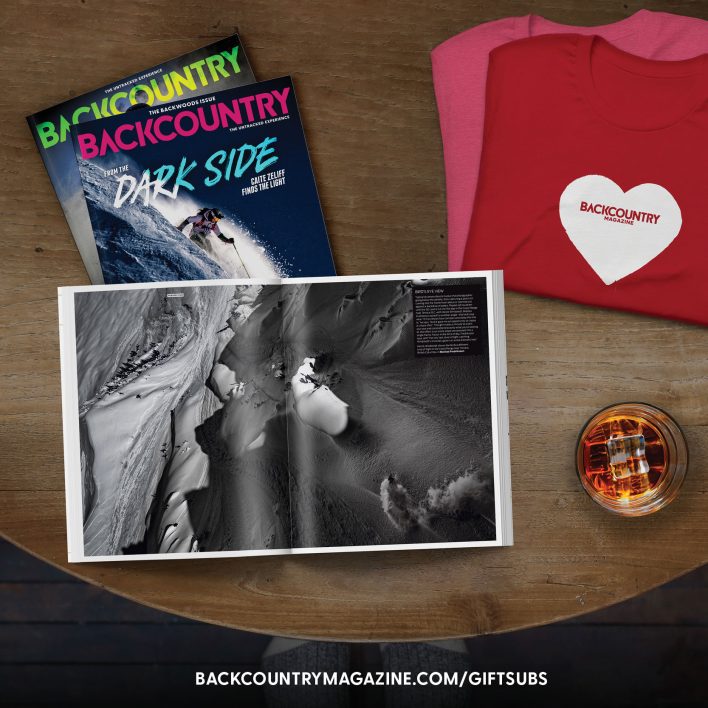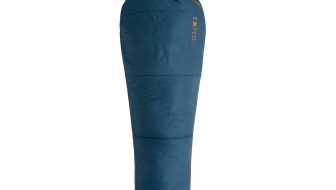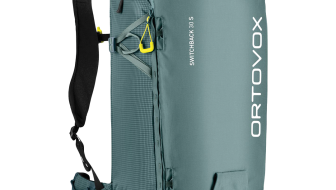
On February 19, my friend Erme Catino and I met up for a trip to Mapleton, Utah, to ski and photograph Spanish Fork Peak. Some years past, there’d been a fire on the mountain above town, leaving a ghost forest that transitioned from oak to large spruce, sweeping to an alpine environment near the summit. Starting in the mud, we shouldered our skis until there was enough snow to skin. Thoughts of contrasting shades, snow and faded tree trunks lured us higher, and it reminded me why I began making ski photos.
As a teenager, I found inspiration from reading ski magazines; they made me yearn for all that untracked white gold. While at university, I slowly accumulated miles on the skintrack in areas I’d explored while hiking or climbing in the summer. They were equally—if not more—amazing during the winter months. The resetting cycle of new canvas upon new canvas where no day was ever the same felt magical. I believed there was a truer backcountry experience by losing count of your strides while setting a new skintrack.
I took my first semi-decent ski image over 20 years ago. On a dark January morning, Ted Johnson and I left Salt Lake City before dawn and drove to the gate on the Mirror Lake Highway. We kicked our way along the road for a mile or two before following sled tracks into a stand of north-facing aspens on the edge of the Uinta Mountains. We crested a gentle ridge as the winter sun broke the horizon and raked the faceted snow below. My turns were gentle and wide, threading through perfectly spaced trees. I stopped halfway down and pulled out an Instamatic camera. Ted’s shadow stretched the distance to me as he and the sun shared space along the ridge. During one of his impossibly slow turns, I triggered the shutter. Two weeks later, I pulled the print from the envelope and smiled. Backlit trees, skis and a flared sun left an imprint as well as a crooked horizon. Ten years after that, I booked my first commercial gig.
Fast forward 10 more years and my M.O. around creating images in the backcountry has evolved somewhat but mostly remains the same. As my skills at making images increased, so did the talent and experience of the people in front of the camera. My circle of friends has grown exponentially, though some have been distanced by either too much risk or not enough. There have been many moments that, instead of occurring impossibly slow, went way too fast. But I’m still striving to capture the true backcountry experience along with feeding my desire to explore. So much so that it drove me to the Mapleton Burn.
At around 9,000 feet, Erme and I were both over it. The snow was shallow and bodyless, and we were wallowing. I asked Erme to give me three setups to shoot. It wasn’t ideal, but I wanted to at least document that we’d been here. I doubted I would ever come back. Erme provided his signature wide, surfy turns. I shot up-slope then cross-slope. I fretted over the protruding brush and thought, “These images will never get published.” Then I took the time to climb a hollow, burned-out tree. I hadn’t climbed a tree for a shot in years, but it offered a wide-angled, down-slope vantage, and I used the bare limbs to frame Erme floating by and reveal the lifeless, mid-February Utah Valley below.
Afterward, I packed up the camera, knocked my boots together and stepped into my skis. Erme waited a couple turns below. As I wrapped around a stand of burnt trees, I felt slightly off. Going into my second turn, I decided to scrub my speed. The shift in weight was met with a violent buck forward. I thought perhaps I would recover, but I quickly gave in to the momentum and rolled; not the worst thing to happen on skis. As I came out of the first roll, my speed stretched my body into full-blown flips. On the third go around, I lost consciousness before traumatically impacting into a tree trunk.
The rescue took three-and-half hours. Erme was able to stabilize me and coordinate a helicopter hoist after dark. I entered the Utah Valley Hospital hypothermic and with a scalped head, a fractured skull, several broken ribs, a collapsed lung, six fractured vertebrae, damage to my spine at the cervical 6 vertebrae and a complete spinal cord injury at the thoracic 4 vertebrae. Seven months later, I am still healing. I get around in a wheelchair, drive with hand controls, ride a recumbent hand-bike and have even begun to work…a little. Physical therapy is constant. Pain is ever present.
People ask if I’m angry. I am not. I’ve reviewed the day a million times, will do so again and can see no critical error. Perhaps, if I’d doubled-checked my bindings…if I’d not gone down to Mapleton…if I’d skied inbounds…stayed home…voted Republican, things might be different. There is a deep regret for putting my family and friends through this roller-coaster ride.
People have also asked if I have a hard time looking at the images from that day. I don’t. If I am being honest, looking at those images takes me to that February afternoon. Dry, cool air radiated from the snow, a thin haze covered the Utah Valley, hollowed-out spruce trees and long shadows stood in contrast to the strange-but-skiable snow. Yes, I wish there had been more time, wish I’d done better, made more of an impact, shown the truth, but the reality is I did take time creating—I mean, I climbed a tree! It’s the same story with every season and with every outing. I still believe there is room to share the truth.
Louis Arevalo is a longtime Backcountry contributing photographer. Following his accident, friends launched a campaign to raise money in support of his family and his recovery that’s ongoing—find it at https://www.gofundme.com/f/love-on-louis-love-on-the-wasatch.
This essay was were originally published in November 2020 in Issue #136. To read more of the untracked experience, pick up your copy here or subscribe.










Thanks for sharing your story, Louis. Best of luck!